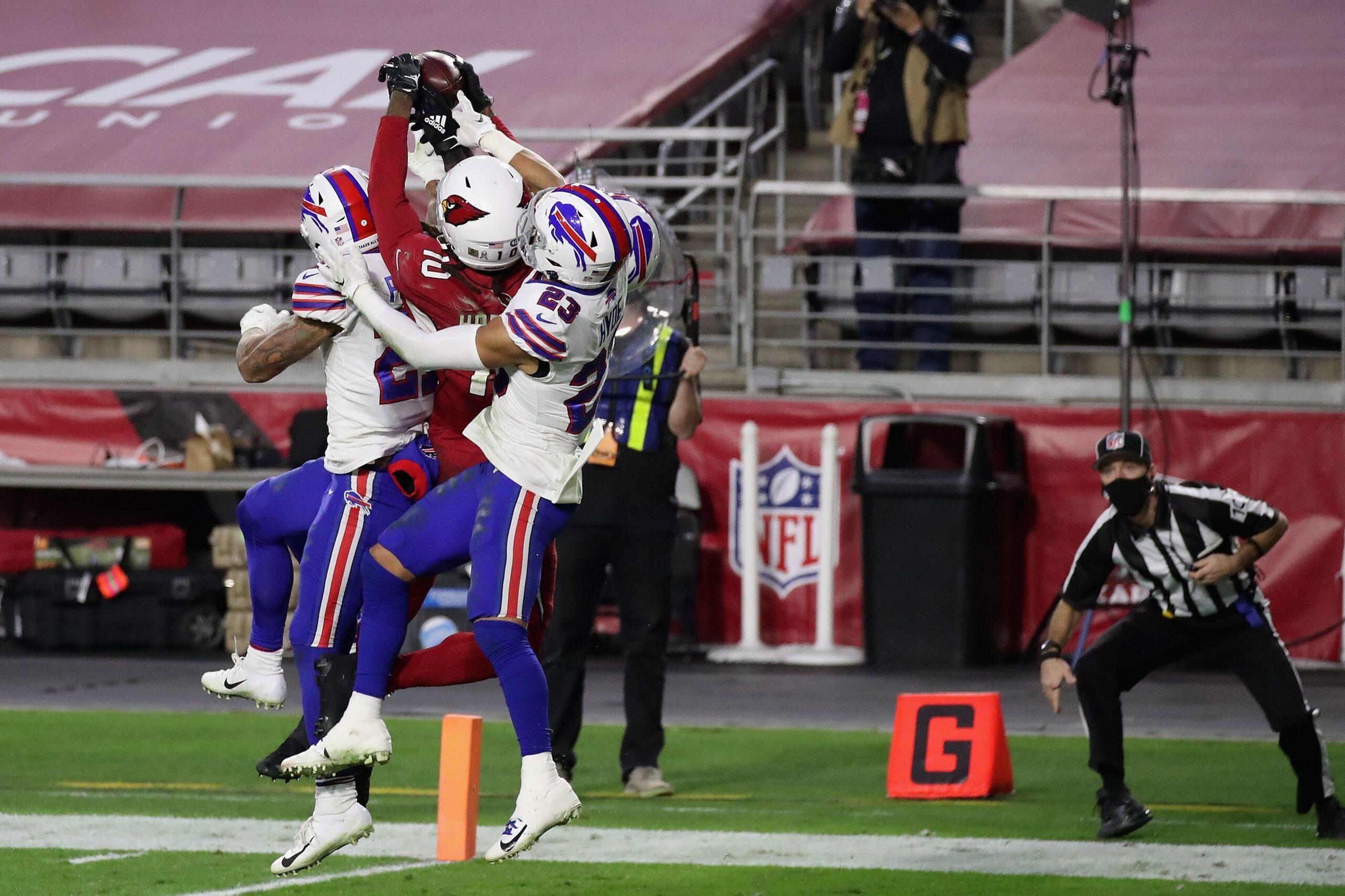On Sunday, the biggest trade of the 2020 offseason officially became the worst trade in years. DeAndre Hopkins made the football play of the season at the end of the Bills-Cardinals game, hauling down a Hail Mary pass while surrounded by three Buffalo defenders. Earlier in the day, his former team managed just seven points against the Cleveland Browns, and did so with an interim head coach at the helm because the guy who traded Hopkins away has already been fired.
Rarely do we see such immediate, definitive results from a huge offseason deal, but then again it is rare to see deals like the Hopkins trade at all. On March 16, as the United States was, uh, busy, the Houston Texans were self-inflicting their own disaster. Head coach-slash-GM Bill O’Brien traded Hopkins to Arizona for the 40th pick in the 2020 draft, a fourth-rounder in 2021, and running back David Johnson. The entire football-media intelligentsia quickly declared the trade a catastrophe for the Texans—after all, how do you ship the best receiver in the game away and not even get a first-round pick in return? Yet somehow, it has worked out even better for the Cardinals than most initially thought, and even worse for the Texans.
Let’s start with the prayer that was answered on Sunday. The Bills took a 30-26 lead late in the fourth quarter after streaky savior Josh Allen tossed a touchdown pass to Stefon Diggs. Ironically, Diggs was also dealt to Buffalo on March 16, hours after Hopkins was traded to Arizona. But this week, Diggs went first and Hopkins delivered the second act. Arizona got the ball back with under a minute remaining and drove to the Bills’ 43-yard line. Then, with just 11 seconds remaining, Cardinals quarterback Kyler Murray took the shotgun snap, ran to his left, stutter-stepped a defender, squared his shoulders, and ripped a pass toward the end zone. As Murray tweeted after the game, “Shiiiiiiiiiiiiid..... [Hopkins] down there somewhere!”
Hopkins was down there, but he was barely visible. The receiver’s arms rose above the Bills defenders while his legs snaked out to his sides like a Kraken rising from the sea—except this Kraken wears XXXXL-sized Jumpman branded gloves.

The players Hopkins subsumes in that photo include Buffalo safeties Jordan Poyer and Micah Hyde, widely regarded as the best safety duo in the NFL, plus cornerback Tre’Davious White, a reigning All-Pro. “They were in position,” Hopkins said in his postgame press conference. “It was just a better catch by I.”
Hopkins was already one of the league’s best receivers when he was traded, but in the past 24 hours, he has become an icon (you can tell because he said “I” instead of “me.”). His 67 catches and 861 receiving yards this season are both second in the NFL to Diggs, the Marcus Paige of this game. But Hopkins coleads the league in first downs (42) and holds the outright lead among all wide receivers in broken tackles (nine), according to Pro-Football-Reference. Most importantly, the Cardinals have been winning since he showed up. In Week 1, Arizona beat division-rival San Francisco 24-20, largely because Hopkins had 151 receiving yards on 14 catches—that broke Larry Fitzgerald’s franchise record for receptions in a game and set Hopkins’s career high. In Week 7, Hopkins had 100 yards and a touchdown in Arizona’s 37-34 overtime win over division-rival Seattle (the game when DK Metcalf ran down that Cardinals defender). On Sunday, Hopkins single-handedly (or more accurately, double-handedly) gave the Cardinals another win. When he went up for that catch, Arizona was in position to be third in the NFC West. When he came down, the Cardinals were first.
This type of instantaneous impact from a trade is rare, especially from a receiver. Plenty of star wideouts have been dealt in the past few years, like Odell Beckham Jr. and Antonio Brown, but they have not had anywhere near the influence on their new teams that Hopkins does. The best recent example of a team getting season-altering production from a trade is the Cowboys, who landed Raiders receiver Amari Cooper at the deadline two years ago. That deal may have been even more impactful than the one for Hopkins; Dallas was 3-4 before Cooper arrived and 7-2 after, and Cooper’s emergence confirmed that Dak Prescott was the Cowboys’ franchise quarterback. Similarly, Khalil Mack created a seismic shift for Chicago when he was dealt there two years ago. But the Bears paid two first-rounders to get Mack, and Dallas gave up a first-round pick to acquire Cooper. All the Cardinals gave up for Hopkins was a second-rounder and Johnson, who might have been released if he hadn’t been traded.
To find a star player who has contributed so much so soon and was sent away for so little, we have to go back to New England’s trade for Randy Moss a decade ago, when Bill Belichick sent a fourth-rounder to Oakland for the disgruntled Raiders receiver. Moss immediately un-gruntled himself in New England and set the single-season record with 23 touchdown catches. But even the Moss trade is an imperfect comparison. Moss was 30 at the time and coming off the worst season of his career. He faced doubts about his attitude, and he was not beloved by the Raiders’ fan base. Hopkins, meanwhile, was one of Houston’s holy trinity of homegrown heroes along with Deshaun Watson and J.J. Watt. He was the team’s best receiver since Andre Johnson and on his way to becoming the best skill player in franchise history. At 28 years old, he is smack dab in the center of his prime. And Houston just gave him away. Superstars have been traded in their primes, or for almost nothing in return, or immediately been elite for their new team—much to the chagrin of the fan base that loved them. But rarely does a trade check all three of those boxes.
Making this situation even more ridiculous is the fact that this trade looks like a catastrophe for the Texans’ present and future regimes. Houston traded Hopkins as part of its plan to Win Now With Bill O’Brien, and that plan is not going well. O’Brien was fired after Week 4, and the team is still reeling from his tenure. Houston managed just one touchdown on Sunday—the same as Hopkins did for the Cardinals—and now the Texans are 2-7 on the season, tied for the third-worst record in football. The offense can’t consistently move the ball (they have the fourth-fewest first downs in the league this season) despite having Deshaun Watson at quarterback, and the receivers the Texans brought in to replace Hopkins—Randall Cobb and Brandin Cooks—have been mediocre at best. Houston’s passing game is bad, but its running game is emblematic of the team’s organizational failure. The Texans should have a strong rushing attack after trading Hopkins for Johnson and spending the equivalent of three first-rounders and three second-rounders on their offensive line. But Houston’s run game ranks dead last in the NFL, according to Football Outsiders DVOA. Johnson went on injured reserve with a concussion last week. Meanwhile, the player the Texans drafted with that second-rounder—defensive tackle Ross Blacklock—had his most memorable moment of the season in Week 2 when he was ejected for throwing a punch in Houston’s game against the Ravens.
Somehow, Houston’s future is even bleaker than its present. The Texans would be on track to have a top-five draft pick next year, but they already traded away their first- and second-rounders in the 2021 draft. Not only have they given away all their good picks, but Houston is also running out of spending money. The team signed Watson to a big extension this summer and lost negotiations with left tackle Laremy Tunsil by about as much as any team has lost any negotiation over the last 20 years. Subsequently, the Texans are projected to be in the bottom quarter of teams in terms of cap space for next season. But teams who spend that much money are supposed to be good. The franchises with less projected 2021 cap space than Houston are a combined 36-17-1 this year, while Houston is 2-7. The Texans are light on talent, cash, and draft picks, and the front office is being run by a former pastor with little football experience. Unless they get a coach who can transform this team, Houston looks ready to turn Watson into the NFL’s Damian Lillard: a fun and beloved star who will waste his prime on a noncompetitive team.
No wonder Hopkins wanted out. He knew asking for a raise would force a trade, and he eventually got dealt to Arizona, who signed him to a two-year deal for $55 million, making him the highest paid non-quarterback in the league. It’s safe to say this was a win for Hopkins, who got gold and is now getting glory; a win for the Cardinals, who are racking up wins on the field, too; and a mega-loss for the Texans, who mortgaged their future for a nonexistent present. Rarely do we see trades like the Hopkins deal, but even rarer can we so quickly judge how the move works out.
